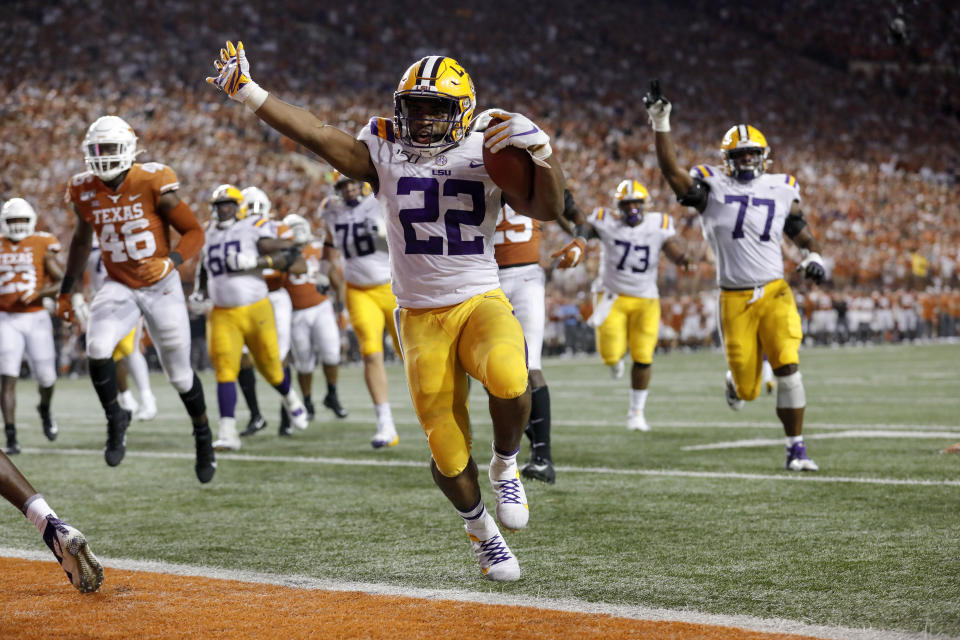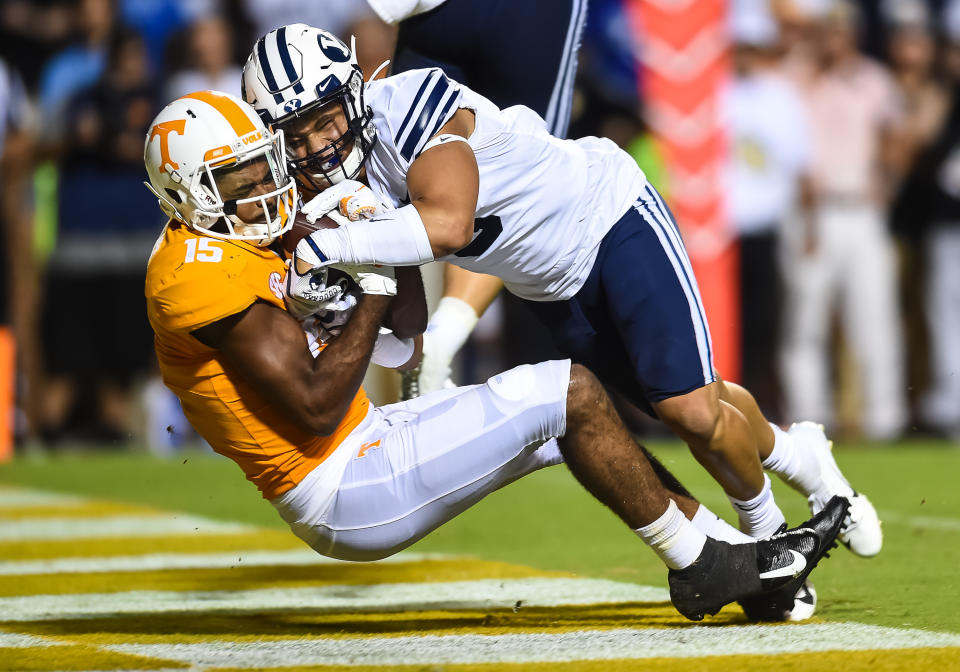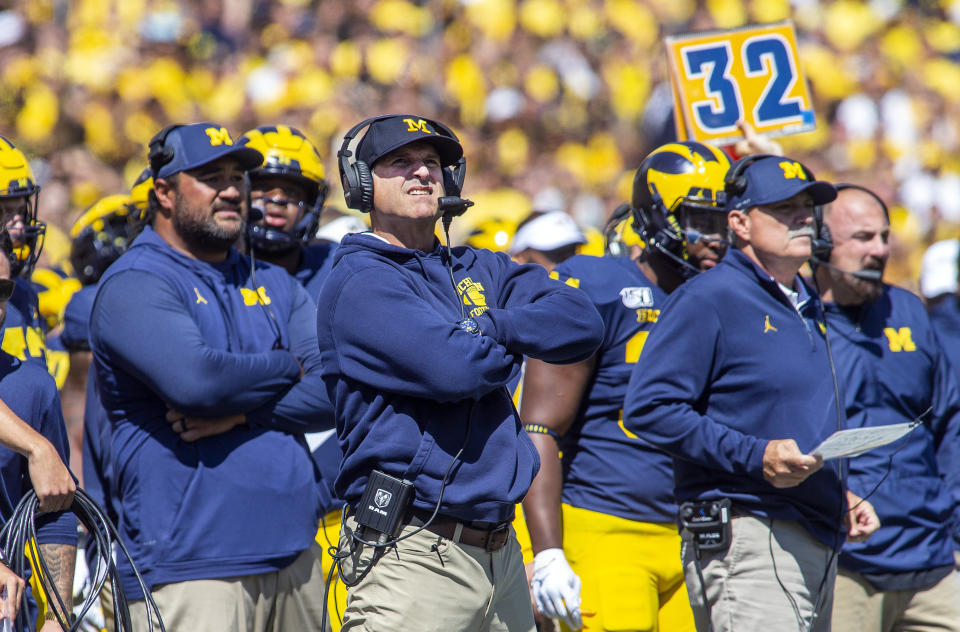10 takeaways: Why LSU may finally be a contender again
Ten takeaways from a dramatic and occasionally mystifying Saturday in college football:
1. We welcome LSU into the 21st Century of offensive football.
The most consistently underwhelming offense in the elite echelon of the sport has roared to life in 2019, just a decade or two behind most of the aerial revolution. It has been the biggest thing preventing the program from competing for a national title since 2011, when it made the BCS Championship Game. But after beating Texas 45-38, the Tigers have announced their arrival as a modern football power.
It’s all changed thanks to a couple unordinary Joes. In the biggest game of the season to date, quarterback Joe Burrow shredded Texas for four touchdowns and 471 yards, the second-most yardage in a game in LSU history. Burrow was good last season coming off a transfer from Ohio State, but well short of great — now that appears to be changing after the arrival of passing game coordinator Joe Brady from the New Orleans Saints.
Armed with Brady’s jazzed-up air attack and a trio of dangerous receivers, Burrow suddenly becomes LSU’s first Heisman Trophy quarterback candidate in 47 years. The last one — and only one in school history — was the Ruston Rifle, Bert Jones, who finished fourth in Heisman balloting in 1972. LSU has only won one Heisman, that by running back Billy Cannon in 1958.
There is, obviously, a long way to go in both the race for the College Football Playoff and the Heisman. But no team and no player are off to faster starts than LSU and Burrow. Jalen Hurts and Justin Fields are yet to face a Power Five opponent. Trevor Lawrence has started slowly. Tua Tagovailoa has been fine, but hasn’t yet had the stage Burrow enjoyed Saturday night in Austin.
Burrow thrived in that charged environment. He was sharp all night, but his biggest throw was his last one: Facing a third-and-10 with 2:27 left and LSU trying to hold a seven-point lead, Burrow navigated a collapsing pocket and got a pass away to Justin Jefferson for the first down — and then Jefferson kept going, turning the corner and completing a stunning 61-yard touchdown play to put the game away.
All that was left afterward was the celebration, which Burrow punctuated with a sassy parade wave to the Texas fans behind the bench after that clinching touchdown. It wasn’t quite Baker Mayfield planting the flag at midfield at Ohio Stadium in 2017, but it will do as a signature moment in LSU’s biggest win in years.

2. Sorry, Sam. Texas is not back. But it’s not not back. Allow me to explain.
After beating Georgia in the Sugar Bowl last season, Longhorns quarterback Sam Ehlinger tweeted what he believed to be the definitive answer to the decade-old question of whether Texas had rejoined the sport’s elite. He was wrong. Or at least premature.
The Longhorns showed they have ground to cover, especially defensively, to get where they want to go. Giving up 573 yards, 45 points and eight scoring drives of more than 50 yards illustrates the work that rebuilt unit has in front of it after replacing eight starters from 2018.
But here’s the good news: Losing a competitive game against a top-10 opponent isn’t a playoff killer. Fourteen of the 20 teams to make the CFP had a loss, with just six teams undefeated. Texas can still build a credible playoff résumé by beating Oklahoma (perhaps twice) and winning the Big 12 championship. This was a loss, but not a terrible loss in which the Longhorns failed to measure up.
So Texas could still be back, if everything goes right the rest of the way. Nothing permanent was lost in the hot Austin night Saturday.
3. You know who else isn’t back? Nebraska.
The Cornhuskers were inexplicably ranked No. 24 to start the season, coming off a 4-8 record last year. Brand name helped, and a lot of voters chugged the Scott Frost Second Season Kool-Aid, after taking Central Florida to a 13-0 record in Year 2 at that school. But the reality is, Nebraska is still weak defensively and error-prone at quarterback.
The Huskers let down the horde of red-clad fans who took over Colorado’s Folsom Field, blowing a 17-0 halftime lead and losing 34-31 in overtime. They were strafed for 375 passing yards, and this time 2018 Nebraska killer Laviska Shenault was only a role player (31 yards receiving, six rushing). Quarterback Adrian Martinez also continued his high-risk, high-reward playing style, producing 356 yards of total offense and four touchdowns but turning the ball over three times.
Bottom line: Nebraska remains winless on the road under Frost. No program can pronounce itself “back” when it has lost eight straight road games.
On the flip side, how about Mel Tucker’s start at Colorado? The former Georgia defensive coordinator has begun his tenure in Boulder by blowing out in-state rival Colorado State 52-31 and then scoring this memorable comeback victory over a bitter former Big 12 rival.
Even Colorado’s famously apathetic fans — how else do you let that many Nebraska fans buy up tickets? — have to be excited about the start of the Tucker Era.
4. From the worst single loss in school history last week to arguably the worst single play in school history this week, it’s been a mortifying start for Tennessee.
The Volunteers had put in 59 minutes and 44 seconds of work into moving past the debacle against Georgia State. They had BYU in a damn near a no-win situation: third-and-6 on its own 20-yard line with just 16 seconds left, no timeouts, offense seemingly in disarray.
That’s when the Tennessee secondary inexplicably broke down, resulting in the kind of play that will populate Big Orange nightmares for years to come. Cornerback Alontae Taylor allowed receiver Micah Simon to run scot free deep down the sideline, the absolute one thing he could not do. Quarterback Zach Wilson stuck the fairly easy throw, Simon swerved past a late-arriving safety and gained 64 yards on the play. The Cougars rushed up to spike the ball, then narrowly made the tying field goal with a second left in regulation.
BYU won it in double overtime. And Tennessee is 0-2 for the first time since 1988.
"Really, you start wondering how you lose that game,” coach Jeremy Pruitt said afterward.
Tennessee has lost nine games now in Pruitt’s 14 as head coach. And the best opponents are all still ahead of this year’s team. Without a substantial upgrade in performance, the Vols seem fully capable of recording their first season of fewer than four wins since — yikes — 1924.

5. Willie Taggart is Jeremy Pruitt with an ounce more luck.
The Florida State coach was presiding over his own potential 0-2 disaster, after his own miserable debut season. But Louisiana-Monroe shanked an extra point in double overtime and allowed the Seminoles to escape, 45-44.
“We won, bro. F--- that,” The Athletic quoted FSU quarterback James Blackman as saying coming off the field. “Let’s fix the mistakes.”
That will require a lot of fixing.
For the second straight week, Florida State threw up a sizable lead against a non-Power Five opponent. Last week it was an 18-point advantage against Boise State, this week it was a 21-point lead on the WarHawks. Last week it was a complete offensive breakdown in the second half, this week it was a spate of turnovers.
This follows a bad script FSU wrote last year: Lose the opener in ghastly fashion, then wobble past an overmatched opponent in Week 2. In 2018 the opening defeat was at the hands of Virginia Tech, followed by a fortunate win over FCS Samford — and in Week 3 the Noles were thrashed by Syracuse. The third opponent this time around is Virginia, which may be the best team in the ACC Coastal.
6. Slighty dramatic take: The butterfly effect from a single five-yard penalty could be felt all season.
When standout Army fullback Connor Slomka flinched and dropped his left hand to the Michigan Stadium turf midway through the third quarter, drawing a flag for a false start, a lot of things changed. All of them bad for the Cadets.
They stunningly led the Wolverines 14-7 and had a second-and-goal from the Michigan 1-yard line. They were one snap away from a two-touchdown lead, and from turning the Big House into an absolute cauldron of pressure for the home team.
But Slomka’s flinch moved Army back to the 6-yard line. On second down, quarterback Kelvin Hopkins Jr. ran for a yard. After a timeout, Cadets coach Jeff Monken opted to do what he hates to do — throw the football. The result was a disaster: Hopkins lobbed one under pressure to Michigan defensive back Lavert Hill, who returned it 20 yards and kept the Wolverines within one score.
Michigan took that gift and drove for the tying touchdown, and the game went into overtime tied at 14. From there the Wolverines pulled out a 24-21 win they should feel a bit embarrassed about.
Here’s the butterfly effect: If Army gets the play off cleanly and takes a 14-point lead, maybe Michigan isn’t coming back. And thus the Cadets go to 2-0 after playing their toughest opponent by far, embarking on a potential magical season, going 12-0 on Nov. 30 at Hawaii and forcing a College Football Playoff crisis.
Because Selection Sunday is Dec. 7, and Army plays Navy on Dec. 14. What would the selection committee do with an undefeated Army team that still had one game remaining?
And, on the other side of the equation, how would Michigan fans react to Jim Harbaugh losing to Army?
The old coaching adage is true: Little things can have big consequences.
7. Did Harbaugh know the score of the game in the fourth quarter Saturday? Because he made two very questionable decisions.
On a fourth-and-2 at the Army 19 with less than 10 minutes remaining in a tie game, Harbaugh blew off the potential go-ahead field goal to go for the first down, and the Wolverines promptly lost four yards. On the next possession Harbaugh went for a fourth-and-1 at the Army 43, with 2:32 remaining in a still-tied game, when punting and forcing a slow-tempo, ground-bound offense to drive the length of the field would have been the smart play. That fourth-down decision ended badly as well, and it gave Army a shot at a 50-yard field goal at the end of regulation that came up short.
“The analytics told us to go for it,” Harbaugh said of the second decision, passing the buck deftly to some vague mathematics compiled by God knows who.
This is the modern coaching equivalent of the old “The Devil Made Me Do It” excuse for bad behavior. If “the analytics” included time, score and style of opponent data, maybe. But I’m guessing they didn’t. It was a bad decision that Harbaugh needed to own and was lucky to survive.

8. Entering the season, all the Clemson buzz (justifiably) was about the offense: Trevor Lawrence, Travis Etienne, all those wide receivers. But two games in, the Tigers’ defense is as dominant as usual.
Despite having five defensive players drafted — three in the first round — Brent Venables’ unit has allowed an average of just 12 points and 292 yards per game. And that’s against a pair of Power Five opponents, while many peers have been playing pushovers. Last year’s elite Clemson defense allowed 286 yards and 13.1 points.
Same as it ever was.
In shutting down No. 12 Texas A&M 24-10 Saturday, Clemson only allowed one running play longer than eight yards and none longer than 11. The Tigers also harassed Aggies quarterback Kellen Mond into a 107.4 pass efficiency rating, far below his career average. Jimbo Fisher’s team didn’t get into the end zone until scoring a meaningless touchdown in the final seconds (meaningful if you had a bet on the game).
With Lawrence performing below the remarkable standard he set for himself in the College Football Playoff last year, Clemson’s defensive prowess has been needed to keep the Tigers winning comfortably. Their streak of 20-point victories was snapped at 11 Saturday, but they’ve still won 12 in a row by at least 14. And, most importantly, the overall winning streak is now 17.
9. Never fear, Kedon Slovis is here.
A whole lot of people pronounced USC’s season over when starting quarterback JT Daniels went down with a knee injury in the opener against Fresno State. That left the job to true freshman Slovis, a three-star recruit whose other Power Five offers were from Oregon State, North Carolina State and Vanderbilt. His first start would be against Stanford, which destroyed Northwestern’s quarterbacks in Week 1.
Get me a rewrite.
Slovis was a sudden star in USC’s 45-20 blowout of Stanford, throwing for 377 yards and three touchdowns in a surprising rout of the Cardinal. At a school with a gilded quarterback history, this was one of the better first starts ever.
Slovis has an impressive array of receiving targets, and he is a great fit for new coordinator Graham Harrell’s offense. That’s one of the reasons why Harrell and head coach Clay Helton elevated the true freshman to second string ahead of more experienced backups, which triggered the transfer of Jack Sears.
Today, Helton’s job security looks better than it has in quite some time. It may not stay that way, but Slovis’ performance gives the Trojans some real hope as a difficult early schedule continues.
10. The Justin Fields-JK Dobbins power duo looks like it can take Ohio State a long way.
Strafing Florida Atlantic in Week 1 was one thing; lighting up a quality Cincinnati defense in Week 2 is something else. Sophomore quarterback Fields accounted for four touchdowns, throwing for 264 yards and getting some nice plays from his receiving corps. Junior running back Dobbins slashed through the Bearcats for 141 rushing yards and two more TDs.
“J.K., when he got to the second level he was rolling today,” coach Ryan Day said. “I thought it was great getting J.K. going and the O-line did an unbelievable job.”
Ohio State was sharp enough to quickly extinguish any Cincinnati hopes for a landmark upset. It was 28-0 at halftime and school was out. In two games, the Buckeyes have outscored their opponents 56-3 in the first half.
The next three games: at Indiana, Miami (Ohio) and at Nebraska. Fields and Dobbins may not face another difficult defense until Oct. 5, when Michigan State visits Columbus.
More from Yahoo Sports:

 Yahoo Sports
Yahoo Sports 